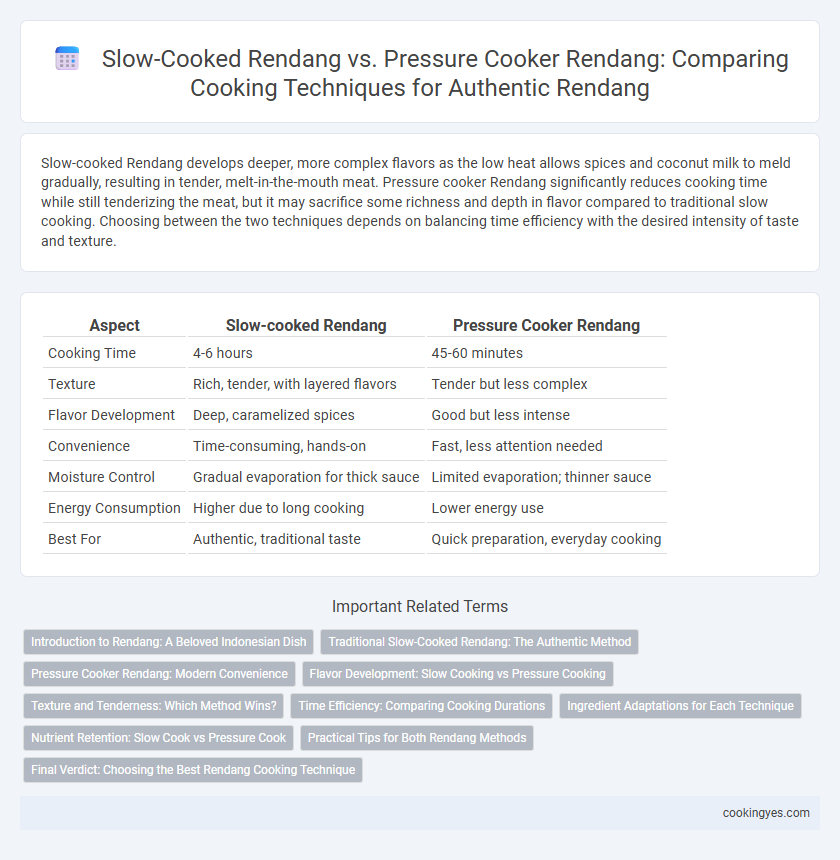Slow-cooked Rendang develops deeper, more complex flavors as the low heat allows spices and coconut milk to meld gradually, resulting in tender, melt-in-the-mouth meat. Pressure cooker Rendang significantly reduces cooking time while still tenderizing the meat, but it may sacrifice some richness and depth in flavor compared to traditional slow cooking. Choosing between the two techniques depends on balancing time efficiency with the desired intensity of taste and texture.
Table of Comparison
| Aspect | Slow-cooked Rendang | Pressure Cooker Rendang |
|---|---|---|
| Cooking Time | 4-6 hours | 45-60 minutes |
| Texture | Rich, tender, with layered flavors | Tender but less complex |
| Flavor Development | Deep, caramelized spices | Good but less intense |
| Convenience | Time-consuming, hands-on | Fast, less attention needed |
| Moisture Control | Gradual evaporation for thick sauce | Limited evaporation; thinner sauce |
| Energy Consumption | Higher due to long cooking | Lower energy use |
| Best For | Authentic, traditional taste | Quick preparation, everyday cooking |
Introduction to Rendang: A Beloved Indonesian Dish
Rendang, a traditional Indonesian dish, is renowned for its rich, complex flavors developed through slow cooking which allows the spices and coconut milk to deeply infuse the meat. Slow-cooked rendang typically requires several hours of simmering over low heat, resulting in tender, caramelized meat and a thick, flavorful sauce. Pressure cooker rendang significantly reduces cooking time while maintaining the essential taste, though it may lack the same depth of texture and savoriness as the slow-cooked version.
Traditional Slow-Cooked Rendang: The Authentic Method
Traditional slow-cooked Rendang involves simmering beef in coconut milk and a rich blend of spices over low heat for several hours, allowing the flavors to deeply penetrate the meat. This method results in tender, flavorful beef with a complex, caramelized sauce that embodies the authentic taste of Minangkabau cuisine. Slow cooking enhances the dish's texture and aroma, preserving the cultural heritage that pressure cooker techniques may compromise.
Pressure Cooker Rendang: Modern Convenience
Pressure cooker rendang delivers rich, authentic flavors in a fraction of the traditional cooking time, making it ideal for busy households seeking the depth of slow-cooked spices. The high-pressure environment accelerates the tenderizing of beef and infuses the complex blend of coconut milk, lemongrass, and galangal more efficiently. This modern convenience preserves the essence of classic rendang while significantly reducing hours of simmering to under an hour.
Flavor Development: Slow Cooking vs Pressure Cooking
Slow-cooked rendang develops deep, complex flavors through prolonged simmering that allows spices and coconut milk to fully meld and thicken, resulting in rich, layered taste and tender meat with a caramelized, slightly crispy exterior. In contrast, pressure cooker rendang significantly reduces cooking time while still infusing the meat with robust spices, but it may lack the same depth of flavor and texture complexity due to the shortened cooking process and less evaporation. For authentic rendang flavor development, slow cooking remains superior in achieving a harmonious balance of spice intensity, coconut creaminess, and meat tenderness.
Texture and Tenderness: Which Method Wins?
Slow-cooked rendang develops a rich, deep flavor profile with tender, melt-in-the-mouth beef enhanced by hours of gentle simmering that breaks down collagen evenly. Pressure cooker rendang significantly reduces cooking time while still achieving tender meat, but the texture is often less complex and slightly firmer due to rapid cooking. For optimal tenderness and traditional texture, slow-cooking remains the preferred method, preserving the intricate balance of spices and succulent meat fibers.
Time Efficiency: Comparing Cooking Durations
Slow-cooked rendang typically requires 4 to 6 hours of simmering to fully develop its rich, complex flavors and tender texture, allowing the meat to absorb the aromatic spices deeply. Pressure cooker rendang significantly reduces this time to about 45 minutes to 1 hour by using high pressure to rapidly infuse the spices and tenderize the meat, making it a more time-efficient option for busy cooks. Despite the shorter cooking duration, pressure cooker rendang maintains much of the authentic taste, though slow cooking remains preferred for traditional depth and texture.
Ingredient Adaptations for Each Technique
Slow-cooked rendang requires prolonged simmering, allowing tougher ingredients like beef shank and coconut cream to fully absorb spices and achieve tender textures. Pressure cooker rendang adapts by using leaner cuts such as sirloin or brisket and reduced coconut milk quantities to prevent curdling under high heat. Both methods benefit from adjusting spice paste concentration and cooking times to optimize flavor infusion and ingredient tenderness based on the technique.
Nutrient Retention: Slow Cook vs Pressure Cook
Slow-cooked rendang preserves more nutrients due to gentle heat and prolonged cooking time, which minimizes nutrient degradation and enhances flavor complexity. Pressure cooker rendang shortens cooking time significantly but may cause some loss of heat-sensitive vitamins like vitamin C and B-complex due to higher temperature and pressure. Both methods tenderize beef effectively, but slow cooking excels in maintaining maximum nutrient retention while developing richer aromas.
Practical Tips for Both Rendang Methods
Slow-cooked rendang develops deep, complex flavors through gradual caramelization and moisture reduction, requiring patience and occasional stirring to prevent burning. Pressure cooker rendang offers a faster alternative, reducing cooking time by up to 70% while maintaining rich taste, but demands careful timing and liquid management to avoid overcooking or dryness. For optimal results, monitor heat levels closely in slow cooking and use natural release methods with a pressure cooker to preserve texture and enhance the aromatic essence.
Final Verdict: Choosing the Best Rendang Cooking Technique
Slow-cooked rendang delivers deeply developed flavors and a tender, rich texture that perfectly balances spices and coconut milk through hours of gentle simmering. Pressure cooker rendang offers a faster alternative, significantly reducing cooking time while still producing a moist and fragrant dish, although it may lack the same depth of complexity found in traditional slow cooking. Choosing the best cooking technique depends on whether time efficiency or authentic, layered taste profiles are prioritized in preparing this iconic Indonesian delicacy.
Slow-cooked Rendang vs Pressure Cooker Rendang for cooking technique Infographic

 cookingyes.com
cookingyes.com